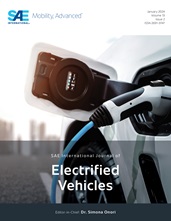A Two-Stage Dynamic Programming-Based Sizing of Hybrid Energy Storage System for Hybrid Electric Vehicles
- Features
- Content
- This article presents a two-stage Dynamic Programming (DP)-based approach to solving the problem of Hybrid Energy Storage System (HESS) component sizing, specifically, the lithium-ion (Li-ion) battery and ultracapacitor (UC) for a mild hybrid electric powertrain. In the first stage, optimal sizing of the battery for the powertrain without a UC is solved for a specified drive cycle, which is used in the reported literature. In the second stage, the battery is complemented with a UC cascaded through a direct current-to-direct current (DC/DC) converter in a semi-active configuration. A DP-based formulation is then constructed and solved for the hybrid energy storage subsystem. While the first-stage DP problem has an objective function to minimize the fuel consumption while sustaining the battery charge at the end of the drive cycle, the second-stage DP problem is solved for minimization of the battery capacity loss (i.e., maximization of battery life and better utilization of the battery in terms of its throughput and stress by the virtue of limiting the power transients/C-Rates). A heuristic layer at the top level of the two-stage DP framework ensures economic sizing of the battery and UC that effectively meets the objectives of arriving at a battery and capacitor size for an economic HESS. This novel approach could be easily extended to multiple standard drive cycles and real-life drive cycles.
- Pages
- 11
- Citation
- Kamat, S., Follen, K., and Chunodkar, A., "A Two-Stage Dynamic Programming-Based Sizing of Hybrid Energy Storage System for Hybrid Electric Vehicles," SAE Int. J. Elec. Veh. 11(1):33-44, 2022, https://doi.org/10.4271/14-11-01-0003.
